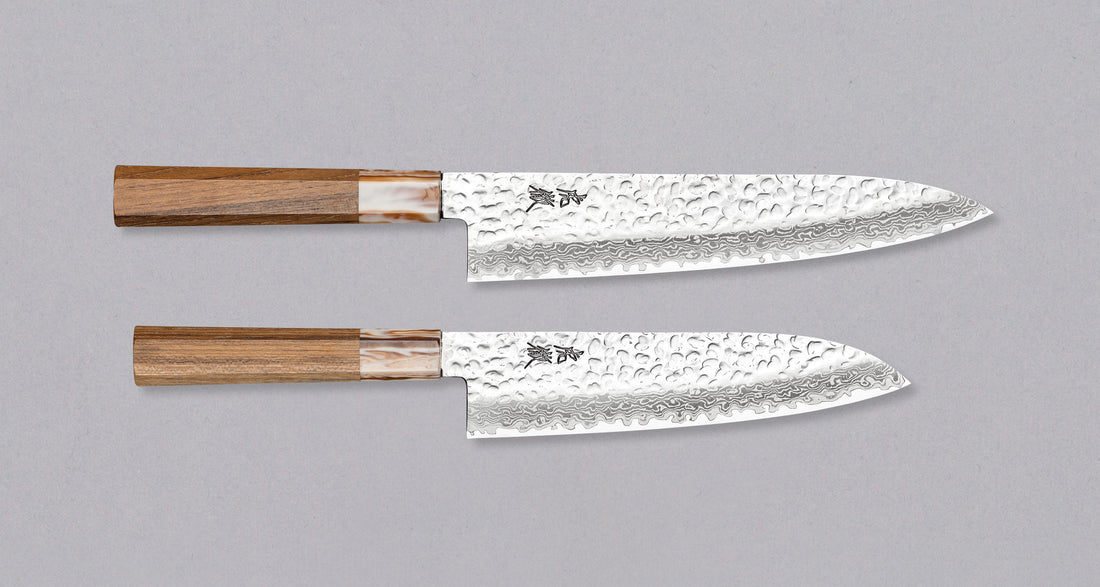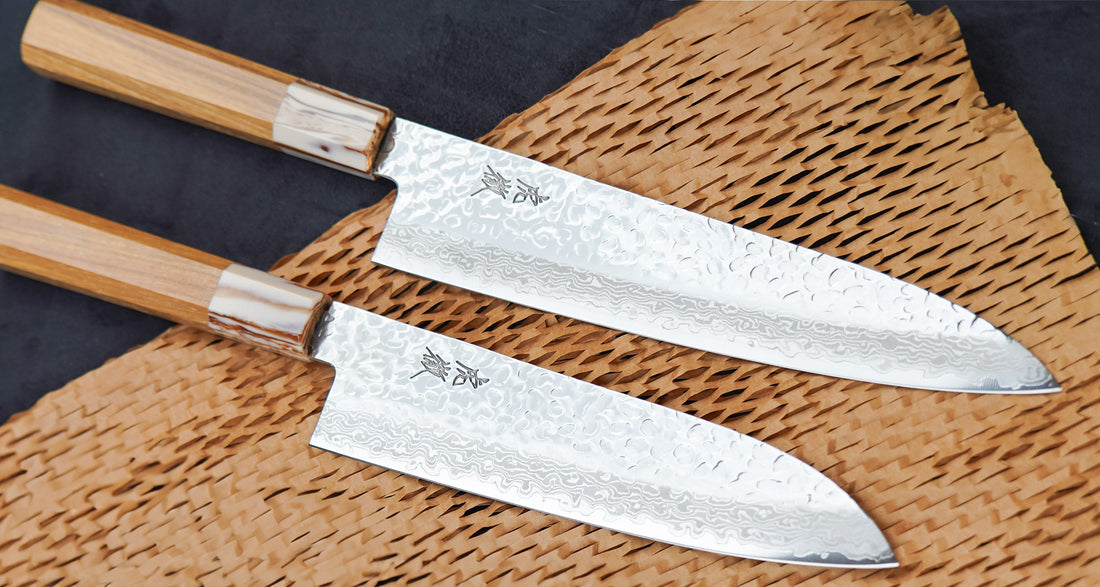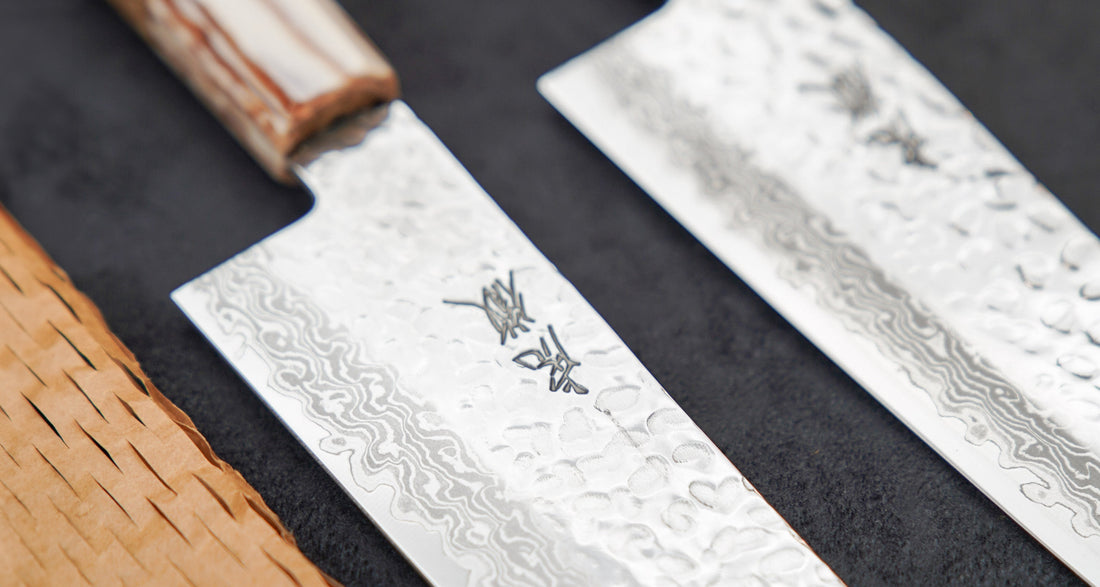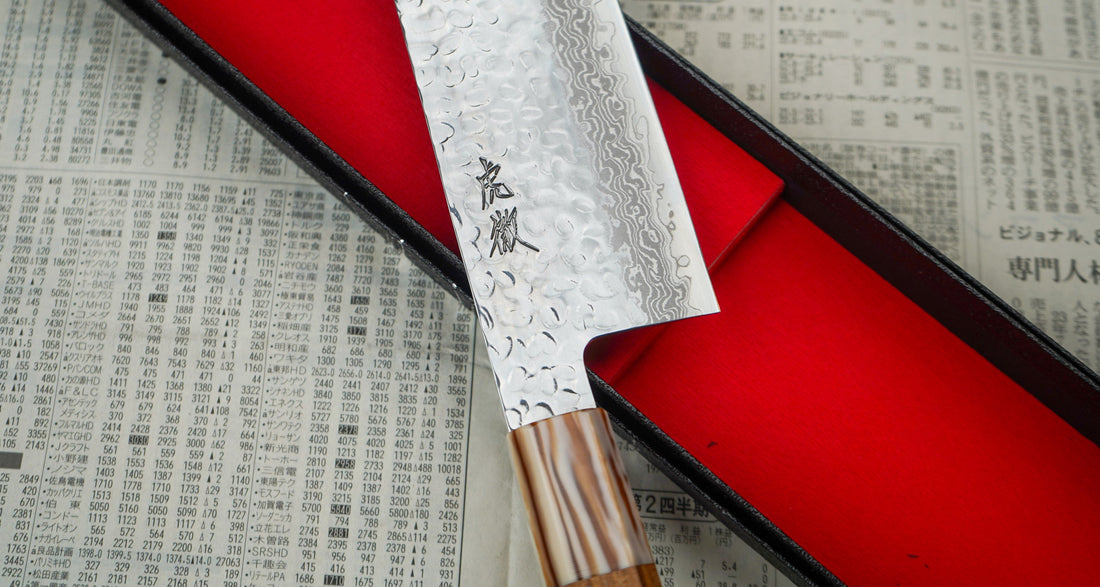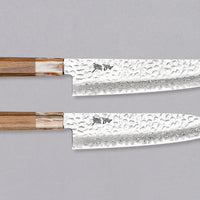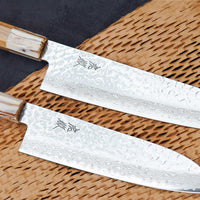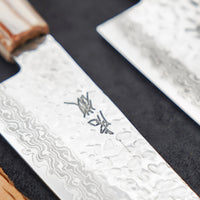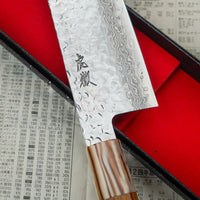[SET] Kotetsu VG-10 Damascus [gyuto + santoku]
|
✔︎ No import fees & duties - worldwide |
- Description
- Specifications
- Knife Care
- Shipping
The Kotetsu VG-10 Damascus Set offers great versatility, featuring two multi-purpose knives that can cover pretty much every cutting-related challenge in the kitchen. This set contains two knives:
Gyuto is the ultimate multi-purpose knife, always ready for any cutting technique — be it chopping, slicing or rocking on the kitchen board. Due to its long blade, it is perfect for slicing larger pieces of meat and fish, as well as preparing vegetables.
Santoku, its shorter and slightly wider counterpart, is also an all-rounder that will handle every kitchen task with ease, but it really shines when it comes across veggies in need of chopping. It is also suitable for cutting smaller to medium-sized pieces of meat and fish.
The excellent VG-10 steel with the hardness of 61 HRC is clad into 17 layers of softer stainless steel with the Damascus pattern, making every knife a unique looking piece.
*The smithy marked the length of the cutting edges as 210mm (8.2") for gyuto and 180mm (7.08") for santoku, but we measured a bit more - approximately 219mm (8.6") for gyuto and 188mm (7.4") for santoku.
BLADE SHAPE:
Gyuto is the most versatile and useful blade shape in the modern kitchen. It has a wide profile for easy food transfer and tends to be fairly flat towards the heel, enabling easy and fast chopping on the cutting board. A pointed tip allows piercing and precise, delicate work. A slight curve between the tip and the midsection makes the belly great for rocking the blade back and forth when cutting. It can be used for cutting meat, fish, and vegetables.
The santoku knife, originating from Japan, is a versatile and multipurpose kitchen knife commonly found in Japanese households. It excels at various cutting and chopping tasks on the cutting board. The name "santoku" derives from the Japanese word "San," meaning "three," representing the knife's three virtues. It effortlessly handles all three key ingredients: meat, fish, and vegetables. It is equally adept at slicing, chopping, and mincing, making it a versatile companion in the kitchen.
The santoku knife is divided into three distinct parts: the tip, which is designed for intricate work, allowing for precise cuts, the cutting edge, which serves general cutting purposes and accommodates a range of tasks, and the heel of the knife, which is perfect for heavy-duty chopping.
If you're in the market for an all-around set of knives that will excel with any kitchen task, whether that is chopping veggies, preparing fresh tuna, or slicing a steak straight from the grill, look no further.
STEEL:
VG-10 is currently the most popular Japanese steel. When deciding between the steels from which we want to make a knife, we consider properties such as hardness, ability to maintain sharpness, ease of maintenance, grain of the steel, ease of sharpening, and, ultimately, price and availability. VG-10 (V for Vanadium, G for "gold", denoting superior quality) is produced by Takefu Special Steel Company, a relatively small company that managed to find just the right balance between the various elements that make up today's most popular Japanese steel. VG-10 is a relatively high (1%) carbon (C), 15% chromium (Cr), 1% molybdenum (Mo), 0.3% vanadium (V) and 1.5% cobalt (Co) stainless steel. The combination of Cr, Mo and V forms a lot of hard carbides, which gives the steel resistance to abrasion and consequently better retention of sharpness.
LAMINATION:
The blades consist of 17 layers of steel. Steels with high hardness have many advantages, but because of their hardness, they are more brittle and thus more susceptible to damage. Blades made of such steels are therefore laminated using the san-mai method, thereby improving their structural integrity and consequently resistance to various impacts and other physical factors that could lead to damage. San-mai means "three layers" in Japanese and refers to a blade that consists of a primary inner layer of harder steel (hagane) and two outer layers of softer steel (jigane) that are made up of multiple layers.
BLADE GEOMETRY:
The blades are double-bevel (symmetrical) and extremely thin, which is key to preparing food with minimal damage to the cell membranes of the ingredients. This enables greater preservation of the taste and appearance of the food.
The thickness of the blade largely determines the sharpness of the knife, as well as easier and faster sharpening.
BLADE FINISH:
The blades stand out because of their hammer impressions that were added across the top of the blade, in combination with a damascus pattern. The wavy shinogi line runs along the cutting edge and marks the boundary between the layers.
Hammer patterns are called tsuchime. Air is trapped in the air pockets during cutting, which helps the blade slide through the food without sticking, which enables fast and accurate food preparation.
HANDLE:
The knives have a classic Japanese handle (wa-style) made of teak wood, with a resin ferrule. The shape of the handle is octagonal, so it fits in both the right and left hand.
SMITHY:
The Yasuda Hamono smithy has been operating since 1957. It is located in the city of Seki (Gifu Prefecture), which is the cradle of blacksmithing in Japan. They are dedicated to research and development, tirelessly perfecting heat treatment and grinding techniques to make the most of the unique characteristics of different steels when making knives. This dedication to knife making has carried over from the original "Sakusaku" brand to brands such as Seki Kotetsu, Gen Kotetsu, and Kotetsu. Knives are the work of dedicated hands of craftsmen who have a deep love and respect for their craft.
Due to its geographical location and natural resources, Seki has been a place where blacksmithing has been perfected for more than 800 years and is known throughout the world as the home of the modern Japanese knife industry. Namely, the blacksmiths of this area transferred the ancient knowledge of forging katanas into kitchen knives.
Blade shape: Gyuto / Santoku
Steel type: VG-10
Blade construction: San-mai / tsuchime
Hardness (HRC scale): 61
Overall length: 363mm (14.3") / 328mm (12.9")
Blade length: 219mm (8.6") / 188mm (7.4")
Blade height: 45mm (1.8") / 46mm (1.8")
Spine thickness: 1.9mm (0.07") / 1.7mm (0.07")
Weight: 155g (5.5 oz) / 140g (4.9 oz)
Handle length: 133mm (5.2") / 128mm (5")
Handle type / wood: Japanese handle [wa] / teak and resin
Kanji on the blade:
Blacksmith: Yasuda Hamono
Location of the smithy: SEKI / Gifu Prefecture / Japan
☝️ Japanese kitchen knives in our store are handmade from natural materials. Slight variations in color, texture, weight and other dimensions are possible. We try to give a good photographic representation of our products, however computer screen resolution and colors do vary, so products might not look exactly as they are seen on screen.

Blade wear depends on the quality of steel, usage and maintenance of the blade. Japanese knives are made of high-quality steels. Follow these tips to keep your Japanese knife in top-notch shape:
✔ Use a wooden, plastic or rubber cutting board.
✔ After use, wash the knives and wipe them dry.
✔ For storage, use a knife holder or a protective knife sheath (saya).
✔ A good cutting technique is your best bet to prolong sharpness.
✔ Use sharpening stones to sharpen the knife.
❗️Don’t leave the knife in the sink. Wash it by hand.
❗️Don’t wash the knife in the dishwasher.
❗️Don’t use the knife on glass, ceramics, marble or steel surfaces.
❗️Don’t scrape the food off the cutting board with the edge of the blade. Use the spine of the knife instead.
❗️Knife is a tool intended for specific use - cutting food. It is not a can opener, screwdriver, trowel, wire cutter, hammer etc.
→ For more details, read our guide
on Maintenance of Kitchen Knives.
🤙 Contact us if you need some help. We reply within 1 business day.
SHIPPING RATES:
- €10 - flat worldwide rate with DHL Express (express delivery, 2-5 business days).
- FREE - all orders over €300 (DHL Express).
EXCEPTIONS:
- United Kingdom - shipping to UK costs €15. All orders are shipped with UPS Express (2-3 business days). Free shipping on orders over €300.
- Russia (currently not available) - shipping to Russia costs €40. All orders are shipped with EMS postal service.
DUTIES AND IMPORT TAXES:
We ship all orders DDP (duties & taxes paid). This means you will not be charged for any import fees and taxes (including VAT). All our prices are final. The price you see at checkout is the final price, no hidden costs.
DELIVERY TIME:
- Europe: 1-2 business days
- US & Canada: 2-4 business days
- Rest of the World: 3-5 business days
RETURNS:
Our return policy lasts 30 days. If more than 30 days have gone by since the day you received your order, unfortunately we can’t offer you a refund or exchange.
→ Read our SHIPPING & RETURNS policy for more info. We strive to solve any issues fast and with as little hassle for you. If you have some additional questions, please contact us.
Each knife comes with:
✔️ Instructions and knife care leaflet.
✔️ A preventive Band-Aid – the knives are very sharp! 😉
✔️ Original box from the blacksmith, which we wrap in an old Japanese newspaper sheet – so every knife is ready to be passed on as a gift as soon as it hits your doorstep!
✔️ We also offer a special gift wrapping option with the traditional Japanese washi paper.
QUIZ
Still doubting which type of Japanese knife should best fit your needs?
We created a 5-steps quiz to help you find the perfect knife based on your cooking skills and the type of food you prepare.


